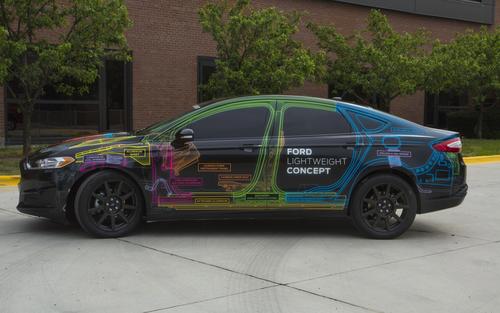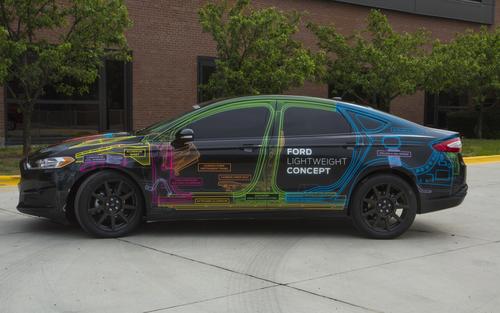July 22, 2014

Ford Motor Co. has been showing off its Lightweight Concept vehicle, which uses several advanced lightweighting materials to reduce the overall weight of a standard production 2013 Fusion by 25%. The rear side windows on the concept car are made with a material combination devised by SABIC Innovative Plastics that saves 35% in weight over a 2013 Fusion window.
The research leading to the drivable concept car, which is based on a Ford Fusion sedan, was developed as part of the US Department of Energy's Vehicle Technologies Program. Ford worked with the Cosma International subsidiary of Magna International to demonstrate several lightweighting solutions with longterm potential. Ford says the same research led to the 700-lb weight loss of the new 2015 F-150 truck, which uses aluminum and high-strength steel.

Likewise, the Lightweight Concept car's design incorporates lightweight materials throughout the vehicle in areas such as the chassis, body, powertrain, battery, and interior components. These materials include ultra-high-strength steels, aluminum, carbon fiber, lightweight plastics, chemically toughened glass, and magnesium. Magna designed and developed the multi-material body-in-white, chassis components, and closures.
The research is specifically focused on developing a lightweight design using the right mix of multiple materials, in a car that can be produced in high volumes, while still meeting required safety, reliability, and durability levels. You can watch a video below about the car's design and materials. In the video, Matt Zaluzec, senior technical leader at Ford's Research & Innovation Center, talks about the need to go beyond simply replacing materials by redesigning and combining multiple components into one, as well as by using advanced manufacturing techniques.
SABIC's part in the Lightweight Concept vehicle R&D was to contribute the polycarbonate (PC) glazing materials that make possible the 35% weight reduction. The company says these materials saved a total of 7.4 lb, despite the fact that the concept car's rear window is thicker than the production glass window it replaces by more than 1 mm. They are a combination of LEXAN resin with the EXATEC E900 plasma coating. LEXAN combines light weight, high optical clarity, and impact resistance, while the EXATEC coating provides long-lasting, glass-like resistance to damage from scratches and UV light.
The LEXAN PC resin is half the density of glass, and has one fifth its thermal conductivity. When glazed with the LEXAN coating, the PC material can help increase energy efficiency by improving the passenger cabin's thermal insulation. The PC material can also be injection molded, so the concept car's rear windows can be designed to reduce additional weight as well as improve aerodynamic performance.
SABIC also contributed engineering design expertise during the rear window's development and production. In addition, SABIC has helped to develop a vacuum equipment technology specifically for the automotive industry for large-scale plasma coating production. Other automotive OEMs have already validated the multi-material technology for use on their production vehicles' rear quarter windows and roofs.
Related posts:
About the Author(s)
You May Also Like



